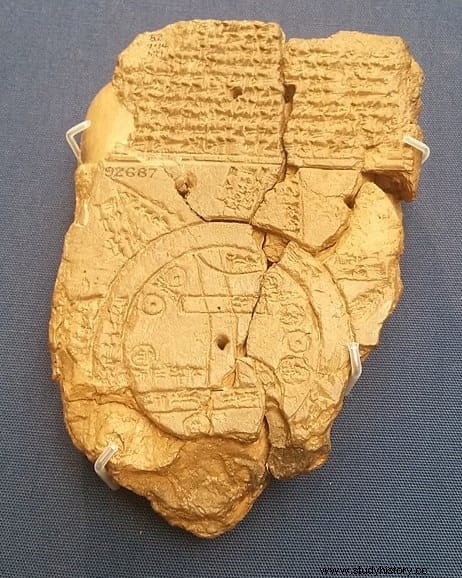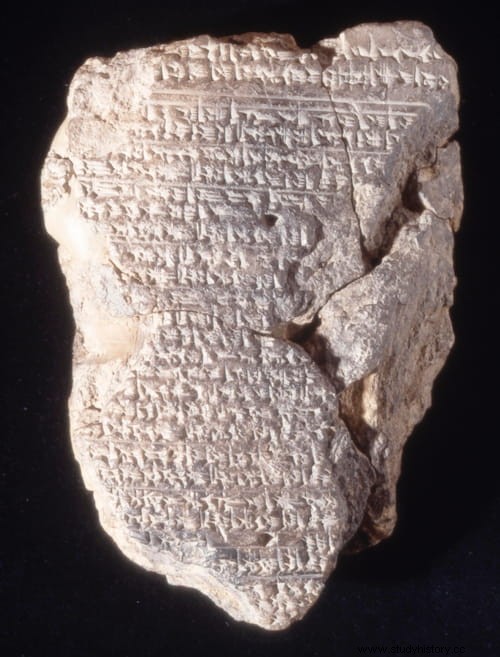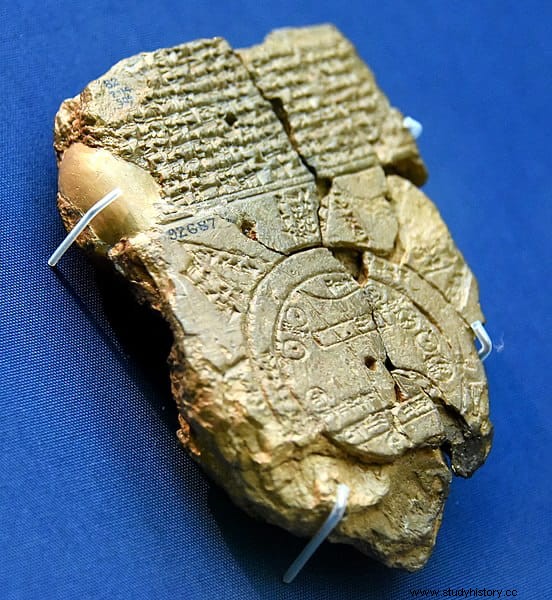Between 1880 and 1881, while excavating the ancient city of Sippar (modern Tell Abu Habbah) some 30 kilometers southwest of Baghdad and 69 kilometers north of Babylon, in a campaign for the British Museum that lasted 18 months, the archaeologist of origin Assyrian Hormuzd Rassam found the Temple of the Sun and in it some 50,000 tablets with cuneiform writing, most of them Neo-Babylonian.
Among them was one that stood out from the others because it included an engraving of what appeared to be a plan or map. However, it was sent to the British Museum and stored with the rest so that Assyriologists could study it. It would not be translated until 1889.
The drawing turned out to be a map of the world known by the Mesopotamians, therefore considered the first world map in history. Other Babylonian maps have been discovered, but this one is unique because it represents the world as a whole, while the rest correspond to plans of cities such as Nippur or Nuzi.

It has been dated to the 6th century BC, during the period of the Neo-Babylonian empire prior to the conquest of Cyrus the Great, when Babylon was at its height and was perceived as the center of the Universe. It contains a text on the map and another on the back of the tablet, both in the Akkadian language. A note at the bottom of the tablet says that the map is a copy of an earlier one, which experts believe dates to as early as the 9th century BC.
It shows the world as a disk surrounded by a ring of water or circular ocean called bitter river . Babylon is indicated as a rectangle on the far right of the Euphrates (although the city actually sat on both banks). The river flows south to a horizontal band whose right end is marked marsh , and the left one as mouth , possibly the swamps at the head of the Gulf and the Shatt al-Arab. A curved line from the north seems to represent the Zagros mountains.

Small circles indicate cities or regions. Two of them identify themselves as Assyria and Der , while the territory of the Bit-Yakin Aramean tribe is located at the mouth of the Euphrates and Habban, the capital of the Kassites is erroneously placed to the west of Babylon. The kingdom of Urartu is indicated to the north of Assyria, and Susa, the capital of Elam, to the south.
Beyond the bitter river circular eight outlying regions are represented as triangles, perhaps to indicate that they were mountainous, and labeled na-gu-u (region). Next to the northwest one is written where Shamash is not seen , reflecting the Babylonian belief that the sun rises in the east, sets in the west, and then returns to the east through the waters of the underworld.
Other elements of the map have not yet been identified. Some are known to represent cities, but no Assyriologist has been able to name them. The circles with dots in the center could not be identified either. Some scholars think they could be cities that were already in ruins at the time the map was made.

On the back of the tablet these eight regions are described, with what appear to be indications of distance between them. A last paragraph says:in the eight regions of the four shores of the Earth, nobody knows its interior . The four shores It was a common expression in Mesopotamia to refer to the entire inhabited world. This text does not appear to be contemporary with the obverse of the tablet.
The text that accompanies the map on the obverse may describe the creation of the world by Marduk, the main god of Babylon:the ruined gods that he (Marduk) put inside the Sea… are present; the viper, the great sea serpent in the interior . These ruined gods would be gods whose statues have deteriorated and need to be repaired, who were thought to have descended to the bottom of the sea, that is, to the underworld.

Two mythical creatures are then mentioned, the bird Anzu (personification of the south wind and storm clouds, who was represented as a bird-man) who stole the tablet of destinies to Enlil, father of the gods; and a Scorpion Man.
Up to 15 animals are listed below, such as the goat, the gazelle, the zebu, the leopard, the bison, the lion, the wolf, the deer, the monkey, the female-monkey, the ostrich, the cat, the chameleon and the hyena, as well as the animal that Marduk created on the wavy sea (perhaps a whale). Except for the cat and the zebu, the others are all exotic animals from distant places, therefore inhabitants of the outer regions .
The next two lines of the text refer to three characters:Sargon I of Acad, the creator of the Akkadian empire in 2270 BC; his opponent Nur-Dagan, king of the city of Purushanda (in the center of present-day Turkey); and Utnapishtim, the sage whom Gilgamesh visits in the famous Mesopotamian poem, in a land beyond the sea and the Waters of Death . All this suggests that the text refers to the inhabitants of the outer regions .

Lastly, it is claimed that the map is a bird's-eye view of the four quadrants of the entire world…which no one can know (since they extend infinitely) . And the last two lines inform us of the scribe who wrote it:copied from his old copy and compiled by the son of Iṣṣuru, the descendant of Ea-bēl-il .
